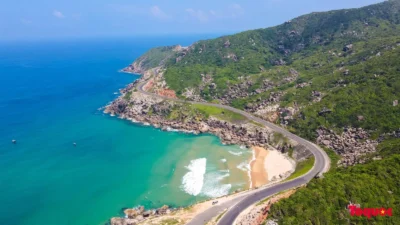Discover the magic of the Mui Ne sand dunes, Vietnam’s very own “Sahara,” where sweeping crimson and ivory hills await just a few hours from Ho Chi Minh City. From adrenaline-pumping ATV rides and sandboarding thrills to serene sunrise vistas and local Cham culture, this comprehensive guide—complete with transport logistics, seasonal advice, offbeat activities, and insider tips—will equip you to plan an unforgettable Mui Ne sand dunes experience.
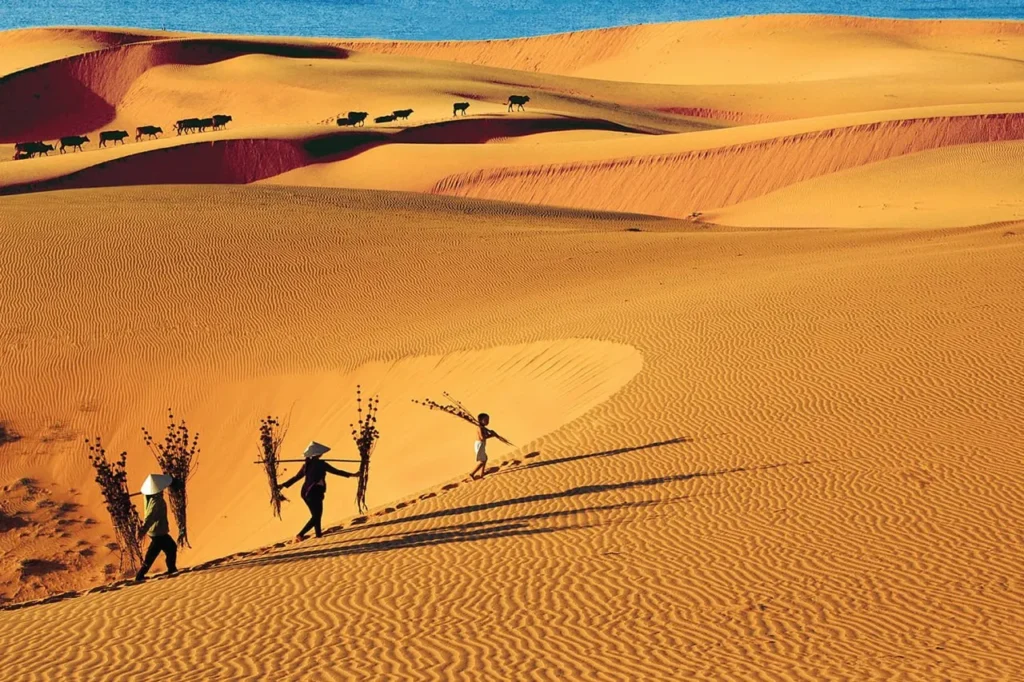
1. Why Visit the Mui Ne Sand Dunes?
Just 200 km from Ho Chi Minh City, the Mui Ne sand dunes transform a seaside fishing town into a desert-like playground of rolling sands and blazing sun. Whether you’re an adrenaline junkie craving high-speed dune rides or a photographer hunting the perfect golden-hour shot, these dunes deliver on every front:
- Spectacular Landscapes: Endless drifts of red and white sands sculpted into rippling hills.
- Adventure Activities: Sandboarding, ATV tours, and jeep safaris for heart-racing fun.
- Cultural Flavors: Meet Cham artisans and nomadic families who call the dunes home.
- Accessibility: Easily reached by bus, train, car, or motorbike from major Southern hubs.
- Bucket-List Sunrise/Sunset: Fiery dawns over white dunes and glowing red sands at dusk.
As one of Vietnam’s most unique natural attractions, the Mui Ne sand dunes deserve a spot on every traveler’s itinerary. Read on to plan your ultimate dune adventure.
2. Geological Origins & Formation
The Mui Ne sand dunes owe their existence to a combination of coastal processes and inland wind patterns. Over tens of thousands of years:
- Marine Sedimentation: Ocean currents deposited fine sands along the shoreline.
- Coastal Erosion: Wave action and seasonal storms moved sand inland.
- Aeolian Transport: Monsoon winds from the northeast and southwest blew sand into vast inland fields.
- Vegetation & Water: Scattered scrub and seasonal rains created dune lakes (“Fairy Springs”) and stabilized some ridges.
Today, erosion and deposition continue in an ever-shifting interplay, reshaping the dunes after each rainy season. This dynamic environment means every visit to the Mui Ne sand dunes reveals fresh patterns and vistas.
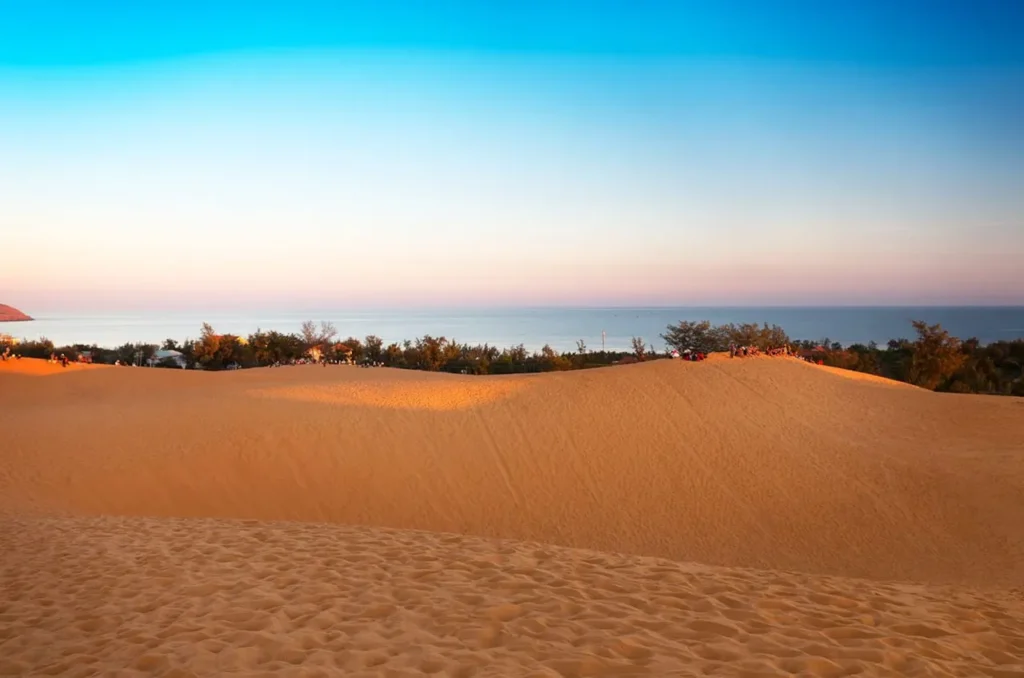
3. Red vs. White Sand Dunes: What’s the Difference?
Mui Ne hosts two distinct dune systems:
| Feature | Red Sand Dunes (Cồn Đỏ) | White Sand Dunes (Cồn Trắng) |
| Location | 6 km northeast of Mui Ne town center | 18 km north, on the way to Ke Ga Lighthouse |
| Color & Composition | Reddish-orange sands high in iron oxide | Bright ivory sands, finer and drier |
| Size | Approximately 50 hectares | Spillover of nearly 70 hectares |
| Dune Height | Up to 15 meters | Up to 40 meters in places |
| Activities | Gentle sandboarding, photo ops, short treks | Challenging sandboarding, ATV safaris, dune trekking |
| Best For | Families and beginners | Adventure seekers and photographers |
Both dune areas are open daily, and most travelers combine them into a half-day or full-day excursion to experience the full spectrum of the Mui Ne sand dunes.
4. Top Activities at the Mui Ne Sand Dunes
The Mui Ne sand dunes offer an array of activities suitable for all ages and thrill levels:
4.1. Sandboarding
- Overview: Slide down dune faces on a mini board—snowboarding’s sandy cousin.
- Tips for Beginners: Start on the gentler slopes of the red dunes. Wear long sleeves and pants to prevent sand burns.
- Advanced Runs: The white dunes deliver steeper descents and longer rides for experienced riders.
4.2. ATV & Jeep Safaris
- ATV Tours: Race across shifting sands, valley tracks, and farmland on 4-wheeled vehicles—guided group and private tours run 30–60 minutes.
- Jeep Safaris: Classic open-air jeeps seat up to six passengers and navigate deeper into the white dunes, dune lakes, and coastal trails.
4.3. Sunrise & Sunset Viewing
- Sunrise at White Dunes: Arrive by 4:30–5:00 AM to watch the first light turn ivory sands gold.
- Sunset at Red Dunes: Late afternoon rays ignite the iron-rich sands into fiery hues—perfect for silhouette photography against local nomads in traditional garb.
4.4. Dune Trekking & Dune Lakes
- Hikes: Follow high-ridge trails for panoramic views of the dune sea.
- Fairy Springs (Suối Tiên): Hidden freshwater pools at the base of the white dunes—ideal for a refreshing dip after trekking.
- Picnics: Spread a blanket atop a ridge and enjoy snacks while soaking in the vast, wind-carved panorama.
4.5. Photography & Cultural Encounters
- Photo Ops: Capture contrast between dunes and fishing villages, coconut groves, and distant ocean.
- Cham & Nomad Families: Engage with local families who rent traditional attire for photos and share folklore of the dunes’ origin.
- Desert Workshops: Some operators offer short tours of local pottery or weaving traditions practiced near the dunes.
5. How to Get There: Transport Options
Reaching the Mui Ne sand dunes is easy from key southern cities:
| From Ho Chi Minh City | Options & Details |
| Bus | Phuong Trang and Hanh Cafe run AC coaches every 30–60 min; fare ~200,000 VND; journey 5–6 hrs. |
| Train + Taxi | SE3/SE4 trains to Phan Thiết (~4 hrs), then 20 km taxi (~300,000 VND) to dunes. |
| Private Transfer | Door-to-door by private car/van (500,000–800,000 VND), customizable departure. |
| From Da Lat | Options & Details |
| Bus | Phuong Trang daily buses; 5 hrs scenic mountain roads; fare ~250,000 VND. |
| Motorbike | Experienced riders can navigate winding highways; expect 5–6 hrs with stops. |
Once in Mui Ne, hire a xe ôm (motorbike taxi) for 50,000–100,000 VND per trip to either dune site, or negotiate a half-day private jeep transfer (400,000–600,000 VND).
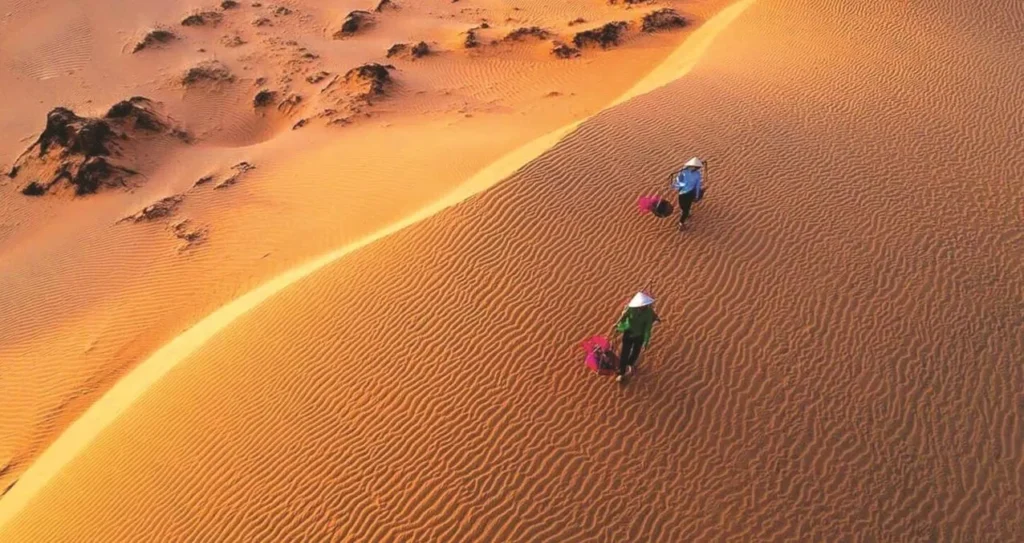
6. Best Time to Visit the Sand Dunes
Choosing the right season enhances your Mui Ne sand dunes adventure:
| Season | Months | Pros | Cons |
| Winter Dry | December–February | Cool mornings (20–28 °C), clear skies, fewer insects | Early mornings can be chilly |
| Hot Dry | March–May | Vivid dune colors, perfect sand shapes | High daytime heat (32–38 °C) |
| Monsoon | June–September | Lush countryside, off-peak rates | Afternoon showers; muddy trails |
| Post-Monsoon | October–November | Dust-free air, refreshed dunes | Sporadic rains; increased insects |
For optimal comfort and activity access, December–February and March–May are ideal windows. If you don’t mind occasional rain and want lower prices, consider the monsoon season with early-morning excursions when showers are less likely.
7. Where to Stay Near the Dunes
Mui Ne’s lodging options span every budget and style:
| Tier | Price Range (USD/night) | Features & Recommendations |
| Budget | ≤ 20 | Dorms and private rooms; basic fan/AC; social vibe. E.g.: The Dorm Mui Ne, Mui Ne Backpacker Village. |
| Mid-Range | 25–60 | Garden bungalows, pool access, beach nearby. E.g.: Mui Ne Hills Budget, Giá Hoàng Resort. |
| Luxury | ≥ 70 | Seafront resorts, spa services, private beaches. E.g.: Anantara Mui Ne, The Cliff Resort & Residences. |
To minimize commute times, book stays in the Ham Tien or Hon Rom zones, which lie between Mui Ne village and the white dunes.
8. Local Cuisine & Nearby Dining
Recharge after dune adventures with these regional specialties:
- Bánh Xèo Mũi Né: Crispy, turmeric-infused rice pancakes loaded with shrimp, pork, and bean sprouts—best enjoyed with fresh herbs and fish sauce.
- Gỏi Cá Mai: A tangy, crunchy fish salad made from local sardine-like fish, tossed with herbs, peanuts, and tamarind dressing.
- Hải Sản Tươi: Fresh-caught squid, clams, and prawns grilled or stir-fried in hot garlic-chili sauces at Mui Ne’s seaside shacks.
- Bánh Căn: Mini rice cakes cooked in clay molds, topped with quail egg or seafood, and dipped in savory broth.
- Sinh Tố Trái Cây: Creamy fruit smoothies—papaya, avocado, mango—and sugarcane juice at roadside stalls.
Most Mui Ne sand dunes tours include a stop at “Fishing Village” eateries on Nguyễn Đình Chiểu Street, where you can sample these dishes with ocean views.
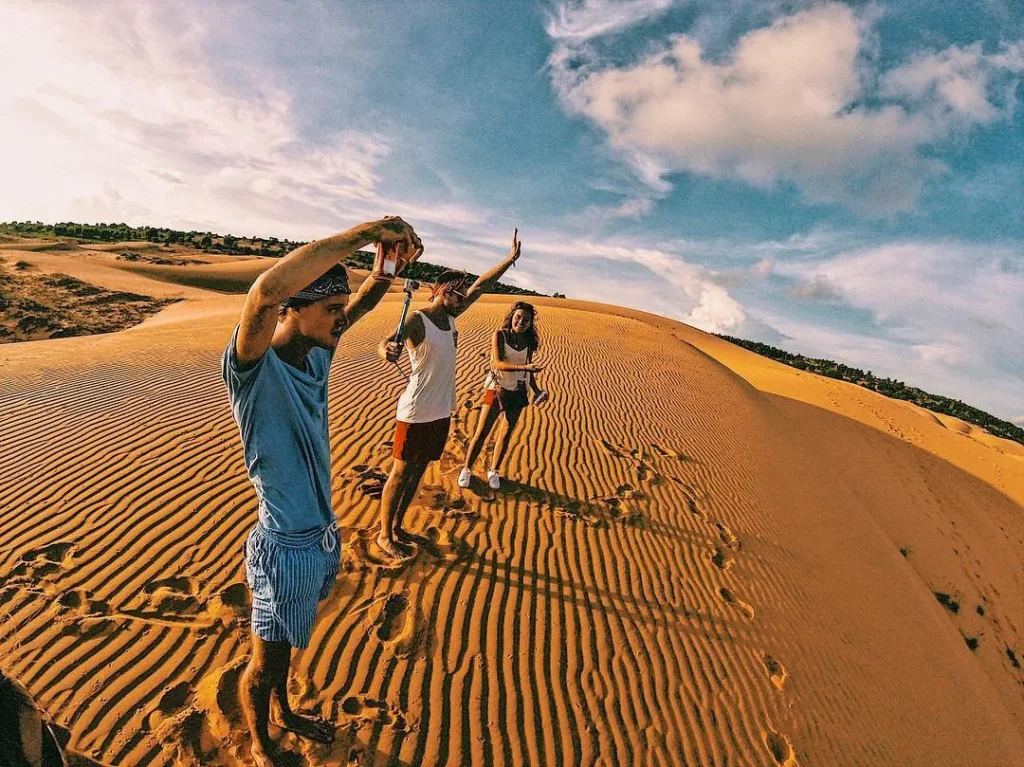
9. Sample Itineraries for Every Traveler
9.1. Half-Day Sunrise Tour
- 4:00 AM: Depart hotel.
- 4:30 AM: Arrive at White Sand Dunes; stake out sunrise spot.
- 5:30 AM: Sandboarding on gentle slopes.
- 6:30 AM: Dune lake trek to Fairy Springs.
- 7:30 AM: Breakfast at dune-side café—bánh mì & cà phê sữa đá.
- 8:30 AM: Return to Mui Ne town.
9.2. Full-Day Adventure
- 8:00 AM: Red Sand Dunes for sandboarding & photos.
- 10:00 AM: Jeep tour across farmland and red dunes (1 hr).
- 11:30 AM: Lunch at local seafood restaurant.
- 1:00 PM: White Sand Dunes—ATV safari (45 min) & dune trekking.
- 3:30 PM: Relax at Fishing Village; fresh fruit smoothies.
- 5:00 PM: Sunset at Red Sand Dunes; capture glowing sands.
- 6:00 PM: Dinner beachfront; enjoy grilled prawns and beer.
9.3. Two-Day Desert & Coastal Combo
- Day 1 Morning: Sunrise White Dunes + Fairy Springs.
- Day 1 Afternoon: Relax on Mui Ne Beach or windsurfing.
- Day 1 Evening: Street food crawl in Mui Ne town.
- Day 2 Morning: Red Dunes sandboarding + ATV.
- Day 2 Afternoon: Visit Fishing Village and local market; depart.
10. Practical Tips & Safety Guidelines
- Dress for Sand: Wear long sleeves/pants to protect from hot, shifting sands; bring a hat and sunglasses.
- Footwear: Closed-toe shoes or sturdy sandals; flip-flops slip off easily in soft dunes.
- Sun & Hydration: Sunscreen SPF 50+, lip balm, and at least 1.5 L of water per person.
- Safety Gear: Always wear the provided helmet and goggles on ATVs or jeeps.
- Cash Only: Bring sufficient Vietnamese đồng—dune entrance fees (15–20 k VND), rentals, and tips require cash; no ATMs on-site.
- Respect Locals: Agree on photo fees with nomad families before snapping portraits; do not disturb their personal spaces.
- Weather Check: In rainy season, morning visits are safest. Confirm tour cancellations ahead of time.
11. Responsible Tourism & Environmental Care
Preserve the Mui Ne sand dunes for future generations by:
- Staying on Paths: Use marked trails and avoid creating new dune scars.
- Packing Out Waste: Carry a reusable bag and remove all trash—plastic harms fragile dune ecology.
- Limiting Noise & Dust: Operate ATVs and jeeps at moderate speeds; respect wildlife and local residents.
- Supporting Local Economy: Hire Cham guides, purchase handmade artifacts, and dine in village eateries.
- Water Conservation: Freshwater is scarce—use toilets and showers sparingly.
By traveling responsibly, you help maintain this unique desert landscape within a tropical setting.
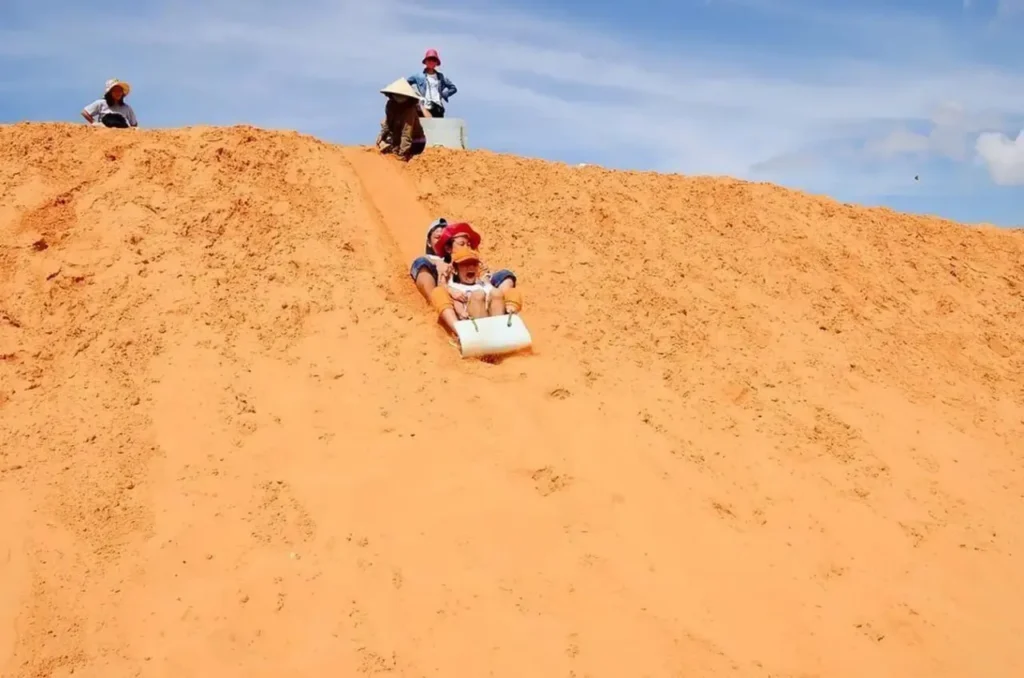
12. Frequently Asked Questions (FAQs)
Q1: How long should I allocate for the Mui Ne sand dunes?
- Minimum: 2–3 hours to see one dune area.
- Ideal Half-Day: 4–5 hours to cover red and white dunes plus activities.
- Full-Day: 8+ hours to include lunch, beach time, and multiple dune experiences.
Q2: Can children participate in dune activities?
- Yes—red dunes are very child-friendly. ATVs often offer tandem rides for younger kids; always check age/height restrictions.
Q3: Are the dunes safe in monsoon season?
- Morning tours are usually safe; heavy afternoon rains can make sands muddy and slippery. Confirm with your tour operator.
Q4: Do I need to pre-book ATV or jeep tours?
- During peak season (Dec–Feb, Mar–May), it’s wise to reserve a day ahead. Otherwise, walk-in rentals are common.
Q5: Is Wi-Fi available at the dunes?
- Very limited—or none—at the dune sites. Use offline maps and inform contacts before you go.
Embrace the Mui Ne Sand Dunes Magic
From dawn’s first golden light on the white dunes to dusk’s fiery glow across the red sands, the Mui Ne sand dunes promise a kaleidoscope of experiences: high-octane adventures, tranquil nature treks, and authentic cultural encounters. Armed with this guide—covering geology, activities, transport, accommodations, dining, itineraries, and sustainability tips—you’re ready to craft your perfect desert-in-the-tropics getaway. So pack your board, buckle your helmet, and prepare to be mesmerized by Vietnam’s very own Saharan spectacle. Safe travels!
Contact VietnamTour now to find the most suitable trip for you.
See more post: My Son Sanctuary: The ultimate tour guide to Vietnam’s Ancient Cham Ruins


